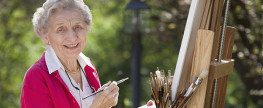
This form of communication can engage intuition and imagination When you receive a serious medical diagnosis, it can feel as though that diagnosis replaces your identity. I am no longer myself — instead, now I am cancer, or heart attack or dementia. But even when we carry a diagnosis, we also continue to live our lives. We are more than our diseases and care plans. People can live as long as 20 years with a diagnosis of Alzheimer’s disease disease. Family and professional caregivers, as well as community members, need tools to ensure that people with Alzheimer’s can be more than their disease. But how? Conversation can be challenging, in person and by phone. How can we stay connected and foster what has come to be called the “personhood” of someone with dementia or Alzheimer’s? The answer is: the arts. A symbolic and emotional communication system, the arts don’t rely on linear memory and rational language. Rather, the arts engage our intuition and imagination. Their building blocks for expression are movement, gesture, words, patterns, sounds, color, rhythm, texture and smell — to name just a few. As access to rational language falters, a person’s imagination can soar. Memory vs. Imagination You don’t need to be an artist to use the arts for expression. These tools are available to everyone. Over the last 20 years, I have worked to encourage care partners to communicate with people who have dementia through creativity. The shift from expecting and correcting memory to opening and connecting through imagination can be profound, especially for family members. After years of distance, the arts can help families rekindle an emotional connection. I remember in one workshop for caregivers, I was demonstrating how they could use open-ended questions...




